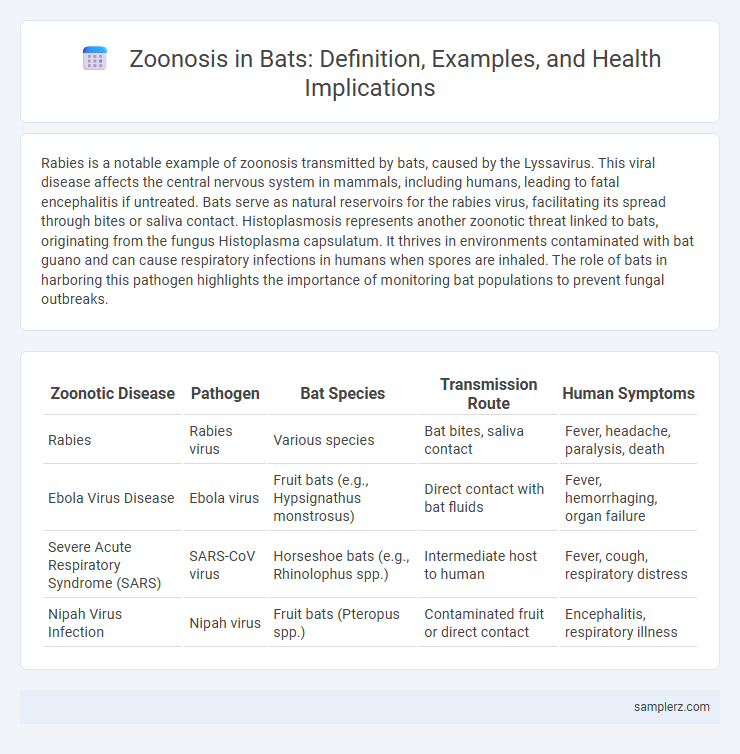Rabies is a notable example of zoonosis transmitted by bats, caused by the Lyssavirus. This viral disease affects the central nervous system in mammals, including humans, leading to fatal encephalitis if untreated. Bats serve as natural reservoirs for the rabies virus, facilitating its spread through bites or saliva contact. Histoplasmosis represents another zoonotic threat linked to bats, originating from the fungus Histoplasma capsulatum. It thrives in environments contaminated with bat guano and can cause respiratory infections in humans when spores are inhaled. The role of bats in harboring this pathogen highlights the importance of monitoring bat populations to prevent fungal outbreaks.
Table of Comparison
| Zoonotic Disease | Pathogen | Bat Species | Transmission Route | Human Symptoms |
|---|---|---|---|---|
| Rabies | Rabies virus | Various species | Bat bites, saliva contact | Fever, headache, paralysis, death |
| Ebola Virus Disease | Ebola virus | Fruit bats (e.g., Hypsignathus monstrosus) | Direct contact with bat fluids | Fever, hemorrhaging, organ failure |
| Severe Acute Respiratory Syndrome (SARS) | SARS-CoV virus | Horseshoe bats (e.g., Rhinolophus spp.) | Intermediate host to human | Fever, cough, respiratory distress |
| Nipah Virus Infection | Nipah virus | Fruit bats (Pteropus spp.) | Contaminated fruit or direct contact | Encephalitis, respiratory illness |
Introduction to Bat-Related Zoonoses
Bats are recognized as significant reservoirs of zoonotic viruses, including rabies virus, Nipah virus, and coronaviruses such as SARS-CoV and MERS-CoV. These pathogens can spill over to humans through direct contact with bat saliva, urine, or feces, or indirectly via intermediate hosts. Understanding bat-related zoonoses is crucial for preventing outbreaks and developing effective public health strategies.
Understanding Zoonotic Diseases from Bats
Bats are natural reservoirs for multiple zoonotic diseases, including rabies, Nipah virus, and coronaviruses such as SARS-CoV and SARS-CoV-2. These viruses can spill over to humans through direct contact, contaminated surfaces, or intermediate hosts, highlighting the importance of monitoring bat populations and their habitats. Understanding bat-borne zoonoses aids in developing preventive strategies to reduce outbreaks and protect public health globally.
Nipah Virus Transmission from Bats
Nipah virus is a zoonotic pathogen primarily transmitted from fruit bats of the Pteropus genus to humans, often through contaminated food or direct contact with bat secretions. Outbreaks in Southeast Asia have demonstrated that consumption of raw date palm sap tainted by bat excretions serves as a key transmission route. Human-to-human spread in healthcare settings further amplifies the epidemic potential, emphasizing the need for surveillance and control measures targeting bat habitats and exposure pathways.
Ebola Virus: Bat Reservoir and Human Infection
Ebola virus exemplifies zoonosis, with fruit bats serving as the primary natural reservoir harboring the virus without showing symptoms. Transmission to humans typically occurs through direct contact with infected bat bodily fluids or consumption of contaminated bushmeat, sparking outbreaks of severe hemorrhagic fever. Understanding bat-virus ecology is critical for predicting spillover events and implementing public health interventions to prevent Ebola virus disease.
Marburg Virus: Spillover Events from Bats
Marburg virus, a deadly zoonotic pathogen, originates from fruit bats of the genus Rousettus and causes severe hemorrhagic fever in humans. Spillover events occur when humans come into contact with bat excreta, saliva, or contaminated fruit, facilitating virus transmission. Outbreaks in Africa highlight the critical role of bat-human interaction in Marburg virus spillover and subsequent human-to-human transmission.
Rabies: Bat-Transmitted Cases in Humans
Rabies is a significant zoonotic disease transmitted from bats to humans, primarily through bites or scratches contaminated with the virus. Several cases of bat-transmitted rabies have been documented globally, emphasizing the critical role of bats as natural reservoirs. Early post-exposure prophylaxis is essential to prevent fatal outcomes following potential rabies exposure from bat contact.
SARS Coronavirus: Bats as Primary Hosts
SARS Coronavirus is a prime example of zoonosis, originating in bats which serve as primary natural reservoirs for the virus. These mammals harbor SARS-CoV strains without exhibiting symptoms, facilitating viral persistence and mutation. Understanding the bat-host relationship is crucial for predicting and preventing future zoonotic outbreaks.
Hendra Virus: Bat-Horse-Human Pathway
Hendra virus, a deadly zoonotic pathogen, transmits from flying fox bats to horses through exposure to bat urine, feces, or birthing fluids in Australia's subtropical regions. Infected horses act as intermediate hosts, facilitating virus spillover to humans via close contact during veterinary care or animal handling. This bat-horse-human transmission pathway underscores the critical need for surveillance, biosecurity measures, and vaccination in horses to prevent Hendra virus outbreaks and protect public health.
Strategies for Preventing Bat-Borne Zoonoses
Bat-borne zoonoses such as rabies and Nipah virus pose significant public health risks due to their potential for spillover into human populations. Effective strategies for preventing these diseases include minimizing direct contact with bats, enhancing surveillance of bat populations for early detection, and promoting public education about the risks associated with bat exposure. Implementing robust biosecurity measures in agricultural settings and conserving natural bat habitats to reduce stress-induced viral shedding also play crucial roles in mitigating zoonotic transmission.
Future Research on Bat-Origin Zoonotic Diseases
Future research on bat-origin zoonotic diseases prioritizes understanding the transmission mechanisms of viruses such as Nipah, Hendra, and coronaviruses including SARS-CoV and SARS-CoV-2. Genomic surveillance and ecological studies are essential to identify viral reservoirs and evolution patterns within bat populations. Innovative approaches integrating virology, immunology, and environmental science aim to develop predictive models for outbreak prevention and targeted public health interventions.

example of zoonosis in bat Infographic
 samplerz.com
samplerz.com